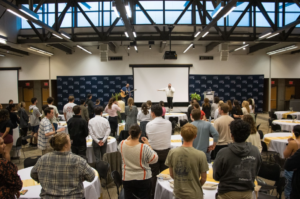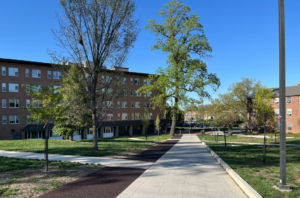Authentic Representation in “Heartbreak High”

Image Courtesy of whats-on-netflix.com
By Mariah Solis
Netflix recently released the new Australian TV series Heartbreak High (2022), which has received praise online from its international audience for its authentic representation of people who are autistic, BIPOC, or LGBTQ+. These characters are incredibly complex, flawed, and well-developed, creating a very refreshing comedy and drama series.
The show is a reboot of the seven-season series Heartbreak High (1994), which was known for dealing with topics like racial tensions in Australia, drug addiction, homelessness, and the obstacles of life. This new series provides a modern story dealing with situations the current generation can resonate with, including topics like consent, gender and sexuality, drug and alcohol use, peer pressure, ableism, and racism. Its ability to cover complex situations with frankness while also keeping the audience laughing and entertained through its Gen-Z humor is comparable to shows like Sex Education (2019) and Genera+ion (2021). That being said, Heartbreak High brings its own unique voice, cadence, and story.
The plot kicks off when a “sex map” detailing the hook-ups and relationships of the student body at Hartley High gets exposed, which was created by former best friends Amerie and Harper. The two were inseparable before going to a music festival together, resulting in undisclosed trauma and a drunken argument that remains an ongoing mystery for the protagonist Amerie throughout the season before finally being revealed.
Following these two separate incidents, the show centers on their falling-out, relationships with other characters, and consequences of the “sex map” getting discovered, including a required sexual education program that is “outdated and heternormative.”
In addition to Amerie and Harper’s storyline, Heartbreak High has a strong supporting ensemble of characters navigating high school while exploring romantic, platonic, and sexual relationships.
The show is getting a lot of traction due to its groundbreaking autism representation through the bubbly character Quinni, played by neurodiversity advocate Chloe Hayden.
TV shows and movies often fail to accurately write and represent autism due to a lack of research, stereotyping, and not including autistic writers and actors in the process. Heartbreak High avoids these mistakes, creating an empowering story for Quinni that resonates with autistic people while also giving non-autistic viewers a chance to better understand the challenges young, autistic women face.
As Digital Spy points out, it is very common for autistic individuals to be LGBTQ+ in comparison to non-autistic people, although it is rarely explored and portrayed in shows and movies. Moreover, even if a character with autism is in mainstream media, topics of sexuality or romance are almost always avoided. By showing an autistic lesbian navigate a new relationship, Quinni’s character completely subverts stereotypes often perpetuated through media.
When Quinni first tells her love-interest Sasha that she is autistic, Sasha seems shocked, asking how she didn’t already realize considering the fact that she has “met autistic people” before. Quinni responds that she is “good at masking,” but the conversation foreshadows the issues looming over their relationship that several neurodivergent people can relate to. As she spends more time with Sasha, Quinni begins to confront her anxiety surrounding people no longer liking her after she stops masking around them.
Quinni is also supported by her ride-or-die Darren, who has their own turbulent storyline dealing with their formerly homophobic dad after coming out as gay and nonbinary. Together, Quinni and Darren face their deeply rooted fear that they are hard to love.
Darren especially confronts this fear when they start to reciprocate feelings for Douglas “Ca$h” Pigott, a closeted gay man and drug dealer that takes care of his Nanna. Ca$h as a character has sparked an interesting conversation about what constitutes good asexual representation, especially considering how few tv shows have an explicit asexual character.
While Ca$h does not have the vocabulary to describe his feelings and experiences with attraction, viewers know through his actions and conversations with Darren that he is asexual or falls somewhere on the asexual spectrum. Heartbreak High portrays what it is like to date as someone who asexual, the acephobia asexual people deal with, and even explores what a relationship between someone who is ace and not could potentially look like. Nevertheless, having the word “asexual” actually said out loud would make the often-overlooked sexual orientation much more visible, and give audience members that resonate with Ca$h the vocabulary needed to describe their own attraction.
Heartbreak High also informed a lot of international fans more about Indigenous Australians through the inclusion of multiple First Nations characters, and the storyline of Bundjalung boy, Malakai Mitchell. The audience meets his character after he is mistaken for another First Nations character, which puts him in the sex-ed class with protagonist Amerie.
A critical moment for Malakai is when he gets racially profiled and physically assaulted by a police officer. The audience watches how this traumatic experience affects him, his relationships, and his life at school. This experience is part of why his character is incredibly important to Australian media and even resonates with international viewers a part of racial and ethnic marginalized communities. Malakai being Blak (short for Blackfullas) is central to his character’s story, and Heartbreak High getting to globally represent Australia Indigeneity could be incredibly impactful to future Indigenous representation in mainstream media.
Heartbreak High has a strikingly diverse cast, portraying characters that pioneer representation for multiple marginalized communities. Diversity and authentic representation may not automatically create an amazing show, but honest performances and well-done scripting that tells the common but often untold stories of BIPOC and LGBTQ+ people make for a better, more compelling show that resonates with viewers and connects everyone a little more to experiences outside their own.







